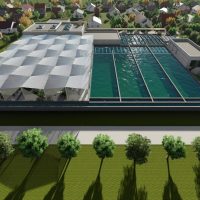What Are the Best Applications for the Organica FCR Solution?
- Are there limitations as to the size of the WWTP?
There are no size limitations to the solution. In fact, larger facilities see more pronounced economic benefits due to increased impacts of operational and construction cost savings. Further, thanks to its modular design construction can be phased according to the pace of increasing needs on site. - What is the largest Organica WWTP that has been built?
Today, the largest operating Organica WWTP treats up to 80 000 m3/day (500 000 PE). However, we have several projects under development and preliminary design that are over 250 000 m3/day. - Is Organica FCR suitable for upgrading existing treatment plants?
Absolutely – Organica FCR can be easily applied to upgrading outdated infrastructure, or meeting increasingly stringent discharge consent requirements. In fact, Organica has completed the upgrade of a WWTP project outside Budapest originally based on a conventional activated sludge solution, treating 80 000 m3/d (500 000 PE).
Upgrade projects are becoming more prevalent, as existing plants are struggling to cope with the demands of growing urban populations and changing regulations. FCR upgrades allow an existing plant to increase capacity and/or nutrient removal performance, commonly within the existing space and infrastructure. An upgrade with The Organica FCR will also have the same benefits and aesthetic appeal as a newly-built Organica facility while also reducing operating costs. In many cases, upgrades with the Organica solution also frees up valuable land, providing additional space for alternative development or other site requirements. - How well does the Organica FCR solution work in areas where contaminant loading conditions vary widely?
Through the use of root structures as a biofilm carrier in the Organica FCR, diversity of the microorganisms substantially increases (3000 species vs. 600-800 in Activated Sludge). This enhanced diversity creates a highly stable system that is able to adapt to unexpected fluctuations in the loading of the influent wastewater. Organica WWTPs are therefore well suited to locations that experience fluctuations in population, such as seasonal holiday resorts. - Can the system be built and operated in “decentralised” plans?
Absolutely – Organica WWTPs are specifically designed to be built and operated in a decentralised manner within urban landscapes. - Can the treated effluent be used as drinking water?
In very few countries around the world is direct potable reuse acceptable. More commonly, we see the reclaimed effluent used for irrigation, toilet flushing, or industrial/commercial applications such as cooling towers.
However, by adding further treatment such as RO filtration and further disinfection, our treated wastewater could meet drinking water standards. - How does this solution help the environment and solve water scarcity?
Organica’s FCR solution is ideal for producing treated water that meets the most stringent regulations for reuse. With a small footprint and attractive enclosure, the treatment facility can be placed near the wastewater source eliminating the need for extensive sewer networks (and associated pumping costs) and minimizing reuse infrastructure costs.

